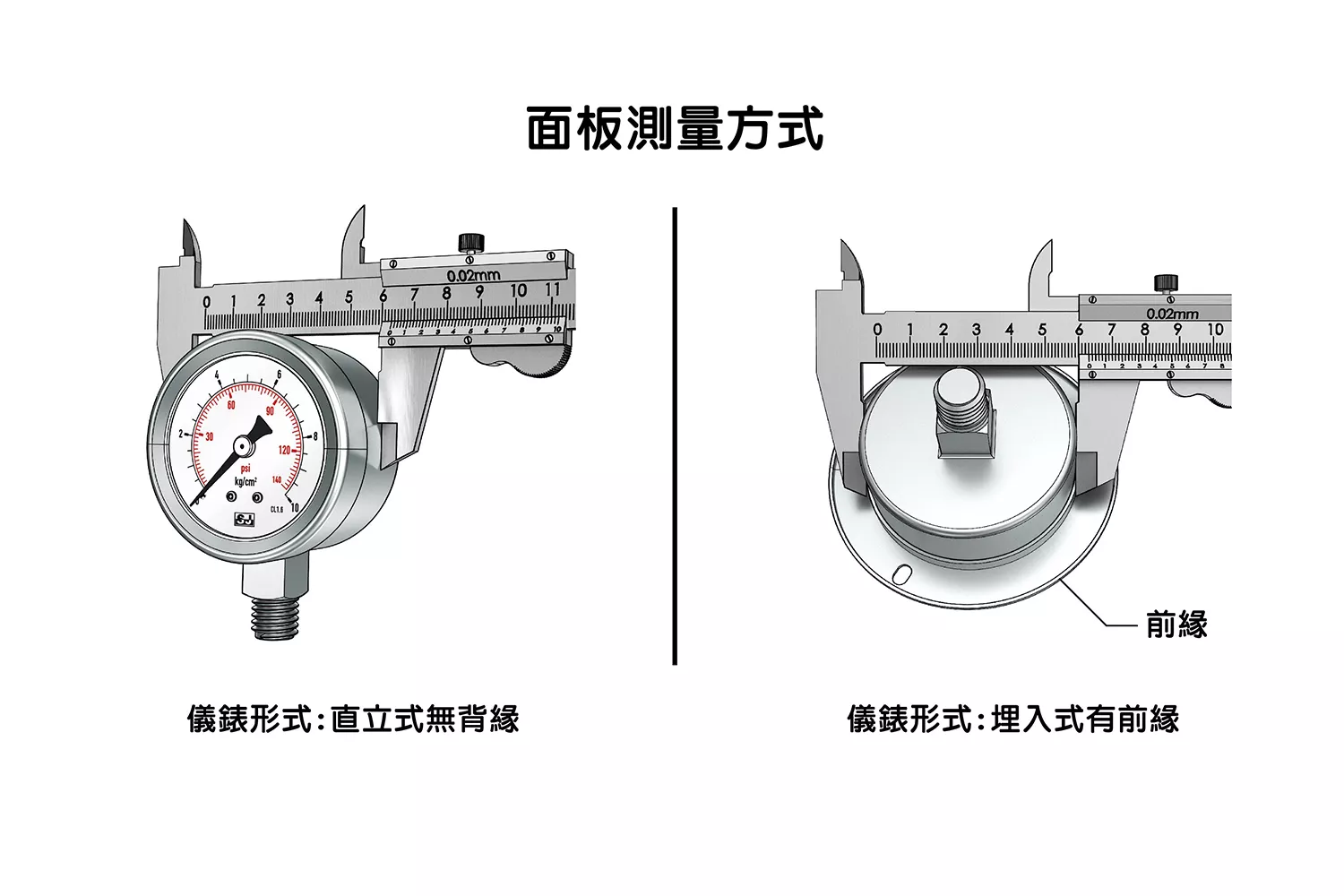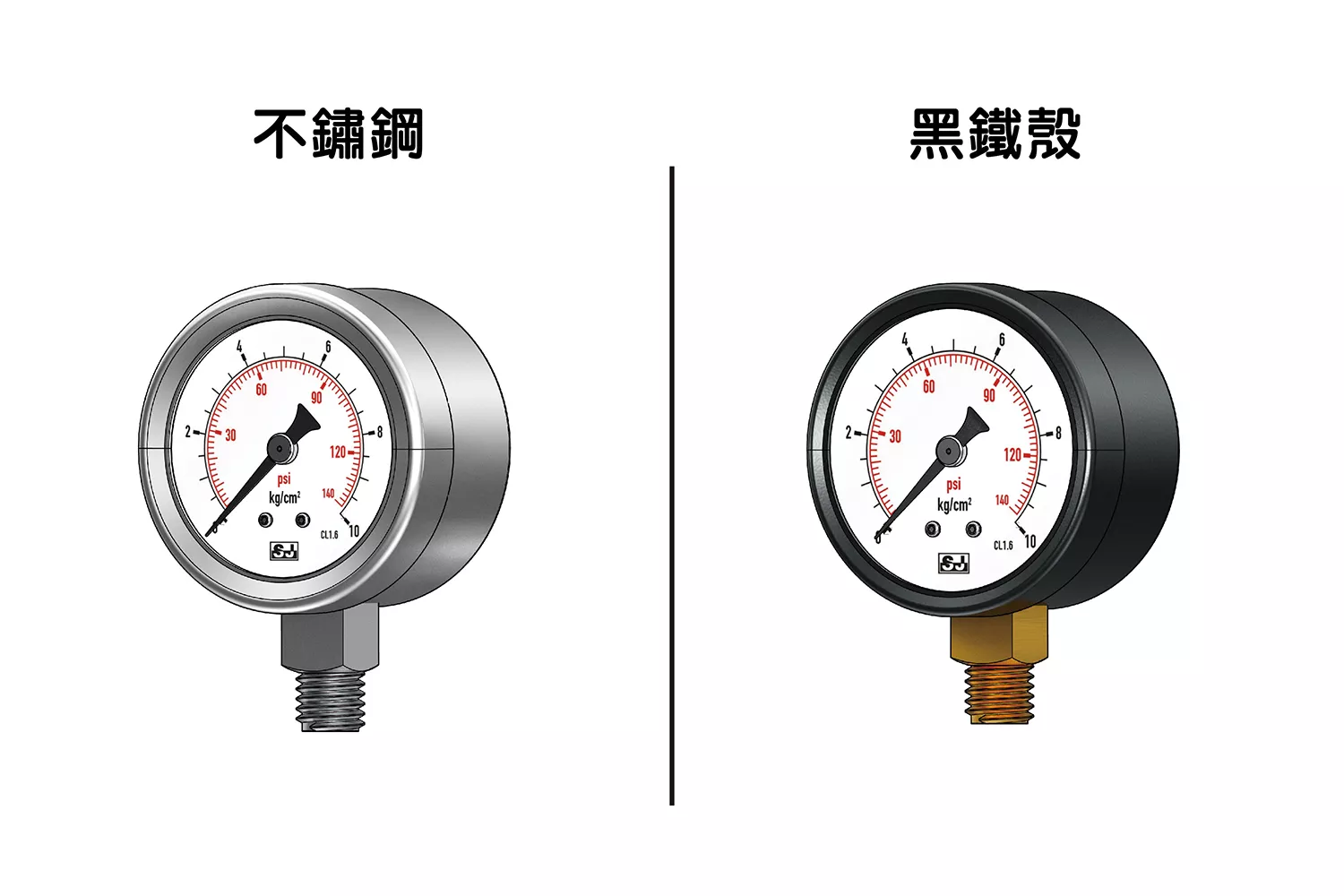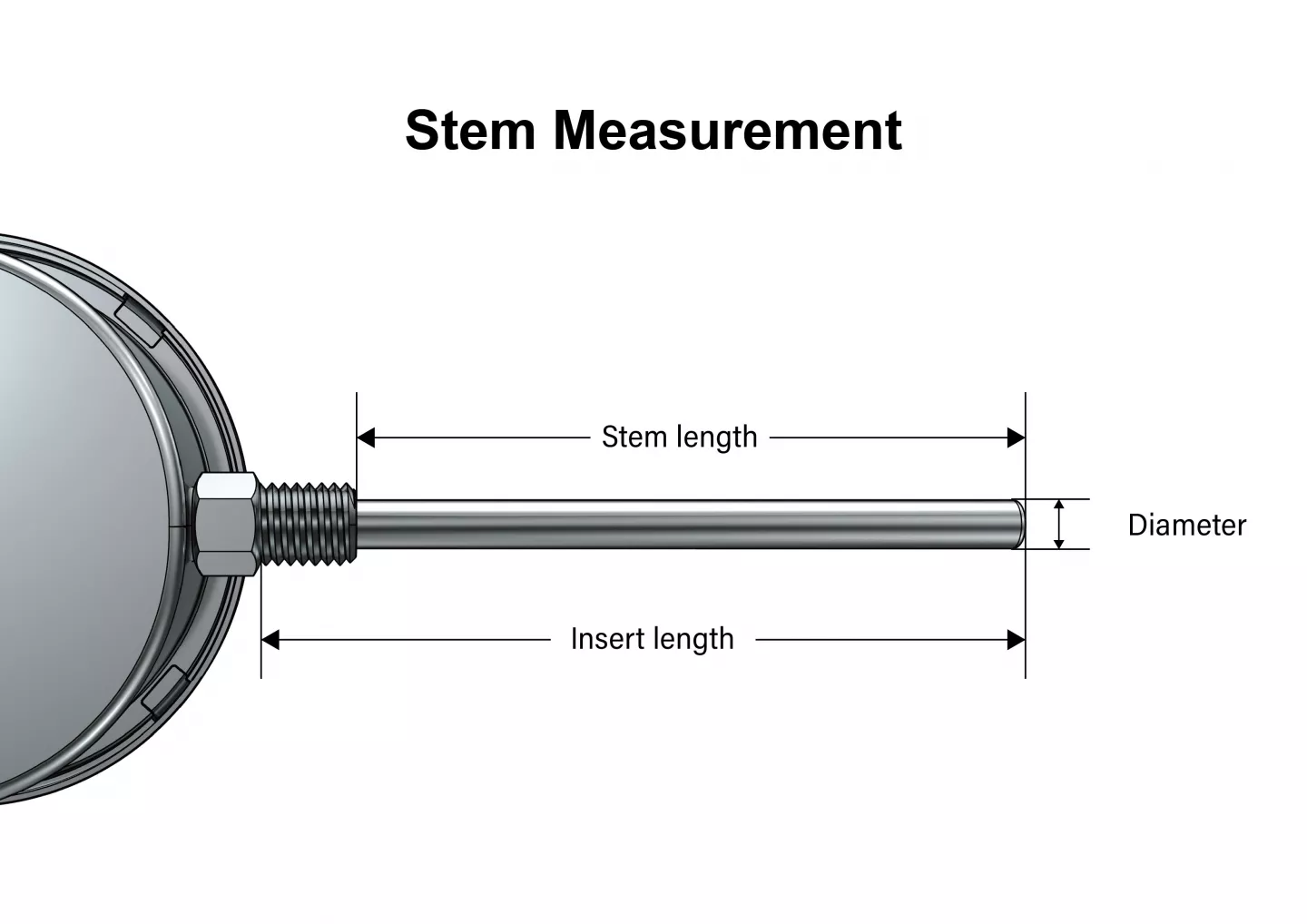How do you choose a thermometer?
If your application requires accurate and reliable temperature readings while ensuring the safety of your equipment and operators,
then selecting the right dial thermometer is essential. Making an incorrect choice could risk damage to your instruments and disrupt your operations.
How do you know if you've chosen the most suitable dial thermometer?
In this article, SJ Gauge delves into critical factors for selecting temperature instruments.
We've compiled six essential guidelines to help you make the right decisions.
If you have further questions about dial thermometers, feel free to contact us at any time.
The experienced team at SJ Gauge is dedicated to offering you the best temperature measurement solutions.
With our support, you'll be able to confidently select the thermometer that suits your needs and ensure the smooth execution of your measurement tasks.
#01Dial Size of Dial Thermometers:
How can you choose an appropriate size for a thermometer dial?
When choosing the size of a thermometer dial, consider these two significant factors:
(1) The distance between the thermometer and the observer. Generally, as the distance increases, a larger dial should be selected to prioritize the readability for the observer.
(2) The physical space around the contact point. Installing a thermometer that is too large for the space could lead to damage and inaccurate readings.
Below is a list of common dial sizes:
(For more detailed specifications on thermometer dial size, markings, and unit indications, you can refer to BS EN 13190.)
- 1" (25mm)
- 1 ½" (40mm)
- 2" (50mm)
- 2 ½" (63mm)
- 3" (75mm)
- 4" (100mm)
- 6"(150mm)

#02Scale Range of Dial Thermometers (Measuring Range):
How can you determine the necessary scale range?
The temperature measuring range should be tailored to the typical temperatures in your application, extending at least two-thirds of the dial diameter. Your measuring range should never exceed the range of the dial face.
For example, if your application's common temperature range falls between a minimum of +10°C and a maximum temperature of +90°C, it is recommended to purchase a thermometer with a dial scale of 0°C to +100°C.
Here is a list of common temperature measuring ranges in accordance with the European standard BS EN 13190, as shown in the table below:
|
Thermometer Dial Range
(Unit: °C)
|
Common Temperature Range
(Unit: °C)
|
|
-20 … +40
-20 … +60
-20 … +120
|
-10 … +30
-10 … +50
-10 … +110
|
|
-30 … +30
-30 … +50
-30 … +70
|
-20 … +20
-20 … +40
-20 … +60
|
|
-40 … +40
-40 … +60
-100 … +60
|
-30 … +30
-30 … +50
-80 … +40
|
|
0 … 60
0 … 80
0 … 100
|
10 … 50
10 … 70
10 … 90
|
|
0 … 120
0 … 160
0 … 200
|
10 … 110
20 … 140
30 … 180
|
|
0 … 250
0 … 300
0 … 400
|
30 … 220
30 … 270
50 … 350
|
|
0 … 500
0 … 600
0 … 700
|
50 … 450
100 … 500
100 … 600
|
|
50 … 650
100 … 700
|
150 … 550
200 … 600
|
Beyond the dial and temperature ranges mentioned in the table above, every application has specific temperature requirements.
When discussing specifications with your instrument supplier, aim for the closest upper limit in the table.
If your requirements exceed that limit, consider the next available range.
What are the consequences of using the wrong temperature measurement range?
Selecting the incorrect temperature range can have adverse effects.
If you choose a temperature range that is too wide, it can hinder data observation.
Conversely, opting for a range that is too narrow carries the risk of instrument rupture or other damage.
If you are uncertain about your specific temperature range requirements, feel free to contact us for the best solution.
#03Connection Location of Dial Thermometers:
How many connection location types of dial thermometer installations are there?
Dial thermometers can primarily be classified into three types based on their installation method and connection location: Bottom mount, back mount, and adjustable angle. The back mount type can further be categorized into flanged and non-flanged, depending on the presence of a flange.
(For more specific temperature gauge installation types, you can refer to BS EN 13190.)

 左右尚有資訊
左右尚有資訊#04Process Connection of Dial Thermometers:
How should you select the right size of a process connection?
Threads can be categorized as straight (parallel threads) or tapered (tapered threads). Standard specifications for thermometer connections in European countries and industrial applications are often referred to as British Standard Pipe (BSP). In contrast, in North American countries, the American National Pipe Thread (NPT) is more commonly used.
You can measure the diameter by clamping a vernier caliper around the thread.
Refer to our previously written article: The introduction and selection of threads.

#05Stem of Dial Thermometers (Thermal Probe):
What is the stem of a dial thermometer, and what is its primary purpose?
The stem of a dial thermometer, often referred to as a thermal probe, is a component of a thermometer used to sense temperature. It is typically composed of bimetallic elements and has an elongated rod-like shape. It is used to directly or indirectly contact the process medium being measured for temperature. Common materials for the stem of a dial thermometer include 304 stainless steel and 316 stainless steel, with a standard rod diameter of 6.35 mm. Various other specifications are also available for custom selection.
How do you choose the right stem of a dial thermometer? How should you calculate its length correctly?
The length of the stem of a dial thermometer primarily depends on the process medium or container you intend to measure.
To achieve optimal temperature measurement efficiency and accuracy, it is recommended that the stem of a dial thermometer be fully immersed in the process medium or at least inserted to a depth ranging from one to two thirds of the stem length. Stems have a minimum length of 50 mm.
When ordering or inquiring about the stem of a dial thermometer, discuss the depth of the process medium, barrel, tank, or container with your supplier. Be sure to specify whether you need the temperature measurement length to include the threads or not. For more details, please refer to the left figure.

#06Thermowells and Protection tubes:
What is a protection tube, and what is a thermowell? What are the differences between them?
Both protection tubes and thermowells are accessories that need to be purchased separately. Their primary function is to prevent the stem of a dial thermometer from being corroded by the process medium, damaged in high-pressure environments, or impacted. They also facilitate the cleaning and replacement of the thermometer while maintaining the equipment's operation.
The most significant difference between a protection tube and a thermowell is that a protection tube is constructed from a single tube. The tip (front end) of this tube is sealed through welding, creating a solid end. In contrast, a thermowell is made from a single piece of solid bar material (circular or hexagonal). The cost of manufacturing a thermowell is also considerably higher than that of a protection tube.
What should be considered when using a protection tube or a thermowell?
When installing a protection tube or a thermowell, it's important to note that isolating the stem of a dial thermometer and the process medium will affect the response (sensing) time of the thermometer. Additionally, differences in the measuring medium and flow rate can impact the time required for the medium's heat to be transferred to the temperature sensor.
What are the common specifications for protection tubes and thermowells?
Common materials for protection tubes and thermowells include stainless steel 304 and 316. In some particularly harsh application environments, Hastelloy alloys and Monel may be used as materials. Alternatively, coatings can be applied to only the parts that come into contact with the medium.
Standard types of thermowells include closed-end thermowells and solid thermowells. Solid thermowell can be further customized. Thermowells come in various shapes, such as tapered, straight, or stepped, depending on the application's requirements. These can be customized with different connection methods, such as flanges, screwed, etc.
For a better understanding of these customization options, reach out to us.

Further Information
Several other critical factors can impact your purchase decision, including calibration, accuracy testing, and pre-factory quality inspection — among others. As your trusted Taiwanese instrumentation expert, SJ Gauge offers comprehensive services, including pre-factory calibration, testing, and quality inspection reports, to ensure our products not only meet but exceed your quality standards and individual requirements.
With over twenty years of professional measurement experience, SJ Gauge is committed to providing you with tailor-made measurement solutions, overseeing the entire process. Whether it's specification selection, component assembly, calibration, or regular maintenance of the thermometer, we will strive to offer high-quality products and support services. Contact us now, and let SJ Gauge help.
Further Information
In addition to the seven key points when choosing a pressure gauge, it is also important to consider calibration, accuracy testing, and quality inspection before shipment. As a trusted Taiwanese industrial instrumentation expert, SJ Gauge provides pre-shipment calibration, testing, and product quality inspection reports to ensure excellent product quality that meets your customized requirements.SJ Gauge offers tailor-made measurement solutions to oversee every step of your pressure gauge procurement process. Whether it's selecting the right specifications, assembling components, calibration, or regular maintenance, we are dedicated to providing you with outstanding products and support. Click to contact us and let SJ Gauge deliver the best customized measurement solutions for your industry applications.
Credit and Reference:
ASME B40.200 Thermometers, Direct Reading and Remote ReadingBS EN 13190:2001 Dial thermometers

In addition to the seven key points when choosing a pressure gauge, it is also important to consider calibration, accuracy testing, and quality inspection before shipment. As a trusted Taiwanese industrial instrumentation expert, SJ Gauge provides pre-shipment calibration, testing, and product quality inspection reports to ensure excellent product quality that meets your customized requirements.
SJ Gauge offers tailor-made measurement solutions to oversee every step of your pressure gauge procurement process. Whether it's selecting the right specifications, assembling components, calibration, or regular maintenance, we are dedicated to providing you with outstanding products and support. Click to contact us and let SJ Gauge deliver the best-customized measurement solutions for your industry applications.








